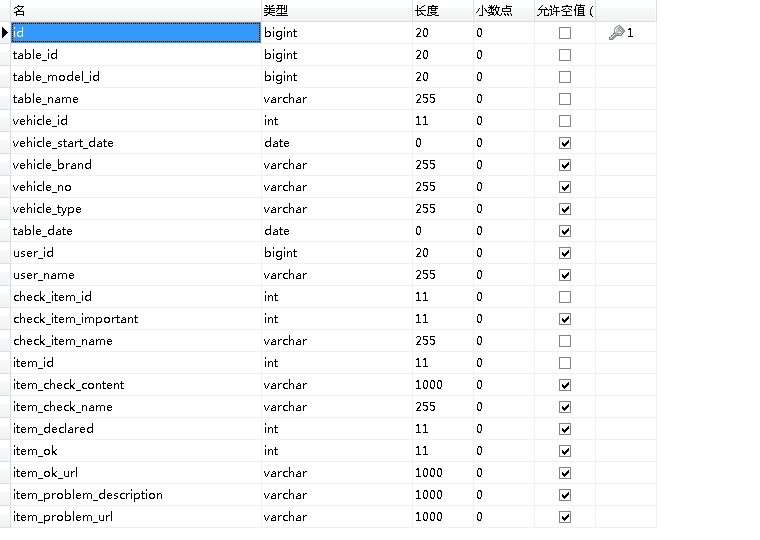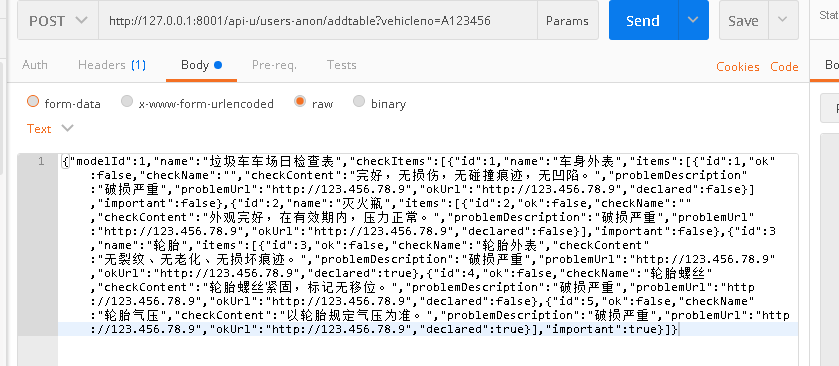Springboot2使用shardingsphere分表攻略
阿新 • • 發佈:2019-05-19
假設我們有一個table_data表,現在要將其分成5個分表table_data0、table_data1、table_data2、table_data3、table_data4

表內欄位大致如下,id為主鍵

我們要使用的是shardingsphere的shardingjdbc模組,新增pom如下(該版本為Apache最新孵化版本)
<dependency> <groupId>org.apache.shardingsphere</groupId> <artifactId>sharding-jdbc-spring-boot-starter</artifactId><version>4.0.0-RC1</version> </dependency>
因為我使用的是mysql8的版本,配置檔案如下
spring:
shardingsphere:
datasource:
names: ds0
ds0:
driver-class-name: com.mysql.cj.jdbc.Driver
url: jdbc:mysql://xx.xx.xx.xx:3306/database?useSSL=FALSE&serverTimezone=GMT%2B8
以上配置中table_data為邏輯表
在SpringBootApplication標籤中新增如下值
@SpringBootApplication(exclude = JtaAutoConfiguration.class)
我們在mybatis的配置檔案中新增一個批量插入
@Mapper public interface TableDataDao { int insert(List<TableData> tableDataList); }
<insert id="insert" parameterType="java.util.List"> insert into table_data (id,table_id,table_model_id,table_name,vehicle_id, vehicle_start_date,vehicle_brand,vehicle_no,vehicle_type,table_date,user_id, user_name,check_item_id,check_item_important,check_item_name,item_id, item_check_content,item_check_name,item_declared,item_ok,item_ok_url, item_problem_description,item_problem_url) values <foreach collection="list" item="item" index="index" separator=","> (#{item.id,jdbcType=BIGINT}, #{item.tableId,jdbcType=BIGINT}, #{item.tableModelId,jdbcType=BIGINT}, #{item.tableName,jdbcType=VARCHAR}, #{item.vehicleId,jdbcType=INTEGER}, #{item.vehicleStartDate,jdbcType=TIMESTAMP}, #{item.vehicleBrand,jdbcType=VARCHAR}, #{item.vehicleNo,jdbcType=VARCHAR}, #{item.vehicleType,jdbcType=VARCHAR}, #{item.tableDate,jdbcType=TIMESTAMP}, #{item.userId,jdbcType=BIGINT}, #{item.userName,jdbcType=VARCHAR}, #{item.checkItemId,jdbcType=INTEGER}, #{item.checkItemImportant,jdbcType=INTEGER}, #{item.checkItemName,jdbcType=VARCHAR}, #{item.itemId,jdbcType=INTEGER}, #{item.itemCheckContent,jdbcType=VARCHAR}, #{item.itemCheckName,jdbcType=VARCHAR}, #{item.itemDeclared,jdbcType=INTEGER}, #{item.itemOk,jdbcType=INTEGER}, #{item.itemOkUrl,jdbcType=VARCHAR}, #{item.itemProblemDescription,jdbcType=VARCHAR}, #{item.itemProblemUrl,jdbcType=VARCHAR}) </foreach> </insert>
以上批量插入的為邏輯表data_table
在Controller中對其進行插入
public void insertTableDataBatch(List<TableData> tableDataList) { tableDataDao.insert(tableDataList); }
測試如下

成功執行後,我們來檢視各個分表
table_data0中如下

table_data1中如下

table_data2中如下

table_data3中如下

table_data4中如下

我們可見這些資料被很好的分配到了5張不同的表中,證明分表對批量插入有
